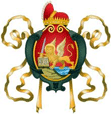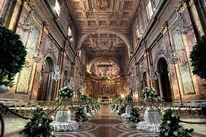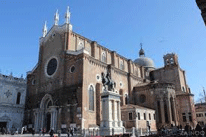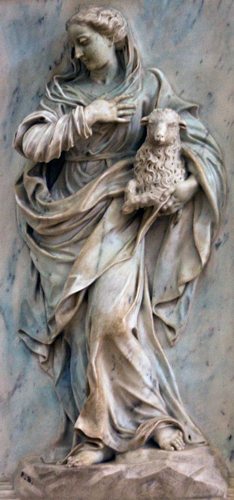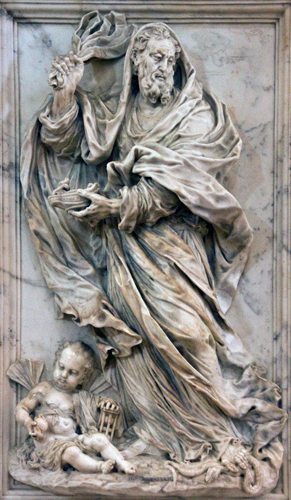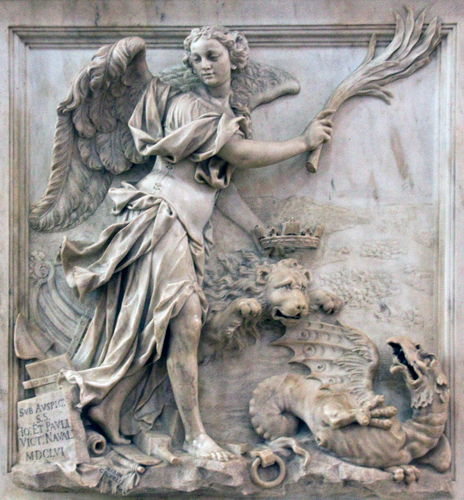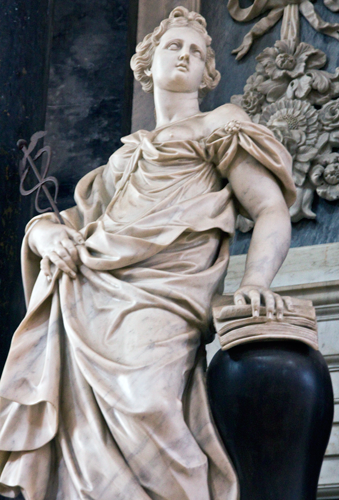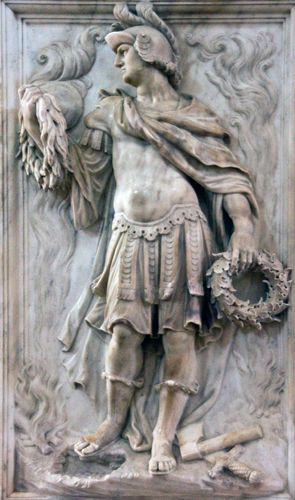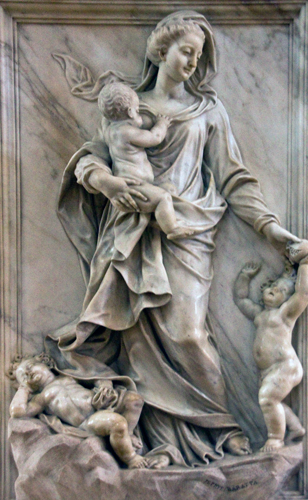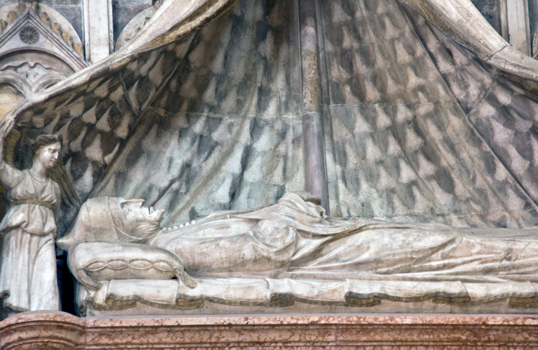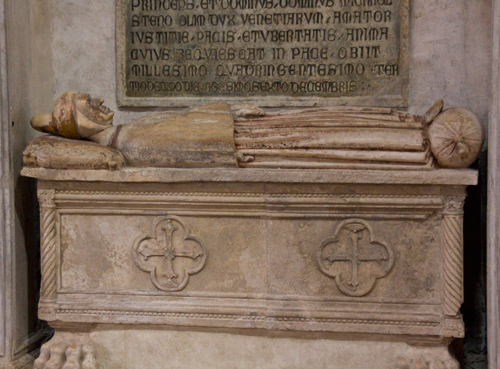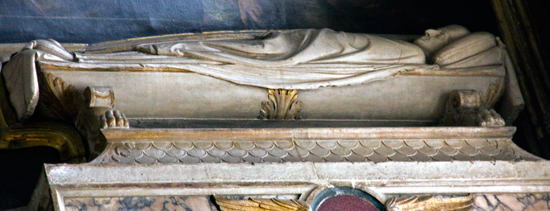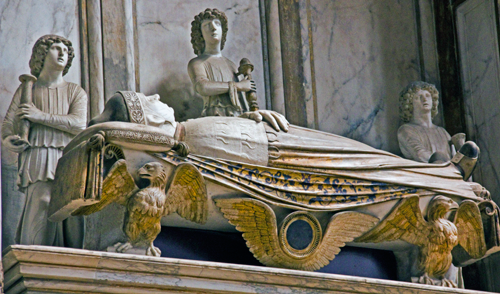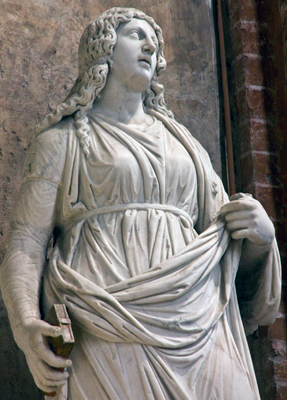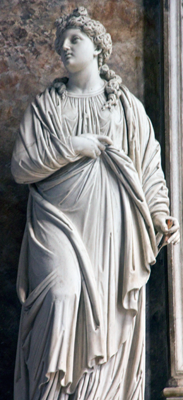| |
|
|
| |
| Church of SS
Giovanni e Paolo |
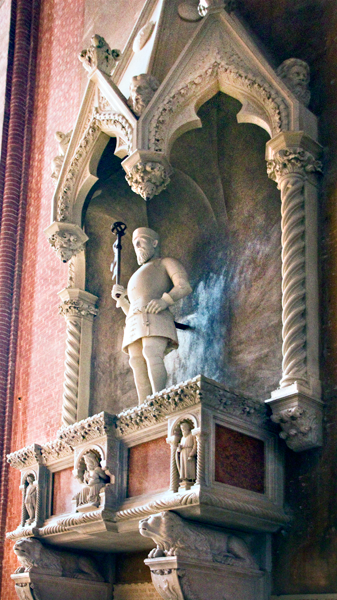 |
Vittor Pisani d. 1380 |
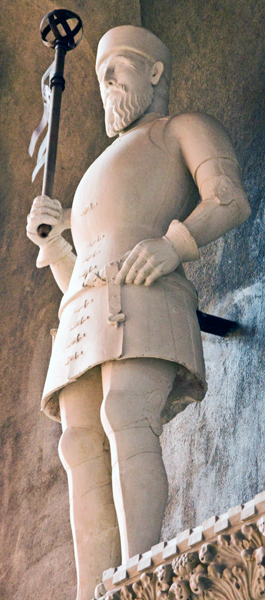 |
Attributed
to Bonino da Campione.
Restored in 1921. |
| Born 1324. He
was commander of the Venetian fleet in 1378 during the war
against the Genoese, whom he defeated off Capo d'Anzio. He was
responsible for the capture of Kotor, Sibenik and Rab. In 1379 the
Genoese fleet turned and defeated Pisani. When he returned to
Venice he was put in prison; however, the people of Venice
demanded his liberation when Venice itself was threatened after
the capture of Chioggia. Given a second chance he was able to
recapture Chioggia with the Venetian fleet and held them off
until peace agreements were reached. In 1380 on his way to
Manfredonia with a fleet of provision ships he died. It is
believed that his palace is now the Hotel Saturnia |
|
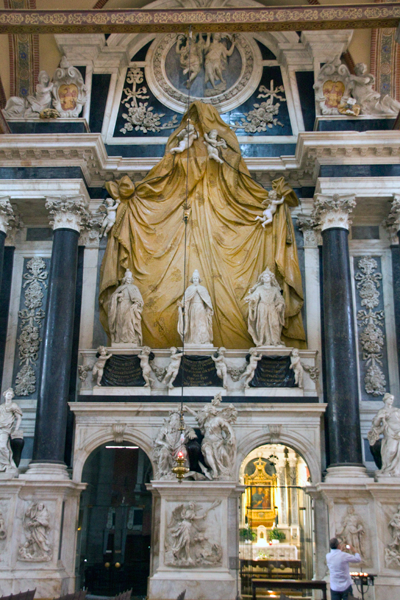 |
Valier
Funeral Monument |
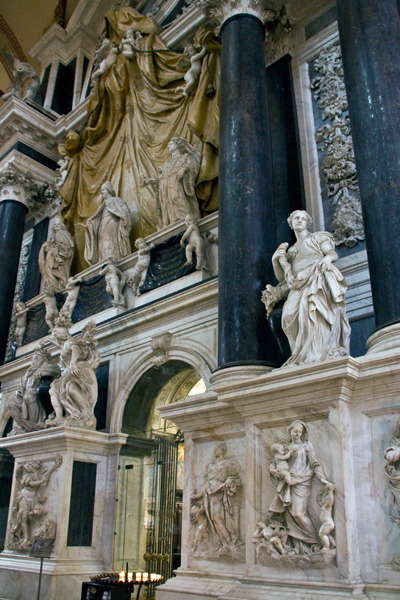 |
|
This is the entrance to the Chapel of
Peace. it represents Doge Bertucci (1658),
the Doge Silvestro (1700) and his wife
Elisabetta Guerrini (1708), created by
Andrea Tirali, based on the drawings by Antonio
Gaspari. It also features reliefs of virtue. |
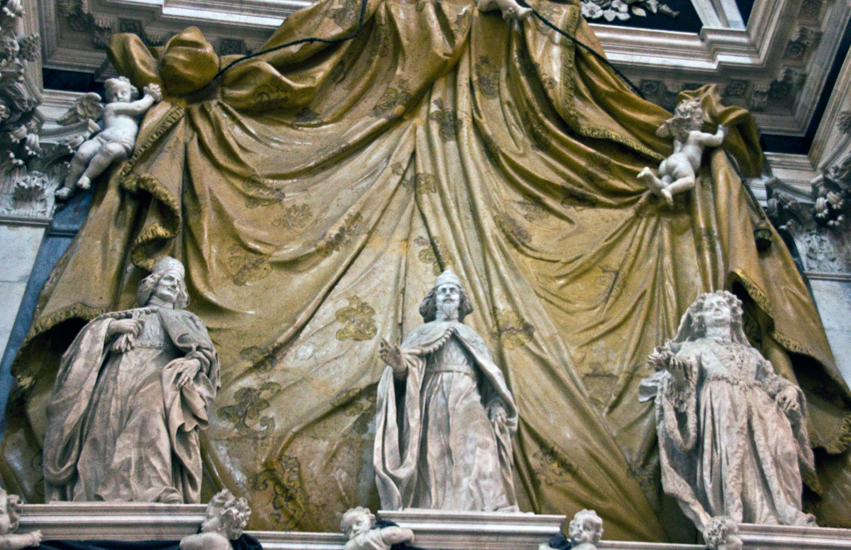
Doge Bertuccio Valiero was born in Venice in July
1596, the son of Silvestro Valiero and Bianca Priuli. He was a
cultured man and married Benedetta Pisani, together having many
children, including his son Silvestro, who would later serve as
Doge, and who appears on the monument. He served as Podesta of Venice's
towns and as Venetian Ambassador to the Vatican during the
pontificate of Pope Alexander VII. In 1656 during the war with the
Ottoman Empire he was considered as a candidate for Doge. He lost
the election, but Francesco Cornaro the victor died only 19 days
later, meaning a second election was held and he was then unanimously
elected. He attempted to bring the Ottoman war to an end but
treaties were rejected and the fleet only had limited success at the
siege of Candia. Desperate for money in 1655 the Jesuits were allowed
to return to Venice on agreement of payment to the state. In 1658,
after suffering from ill health for many years he finally died in
March 1658,.
Silvestro Valiero was born in Venice in March 1630.
Son of the above, he married Elisabetta when he was
19. He became procurator by buying his way into the office. He was
interested in the diplomatic affairs of the state. He was considered
a good speaker, loved the good life but was also generous to the
poor and gained the people's affection. |
| He was elected as Doge in 1694 after
the Republic decided they wanted someone who was not ambitious,
because of the poor economic state through war. The council had
done away with the grand procession reserved for the Dogaressa,
but they were persuaded to reinstate it for Elisabeth. in March
1694; she appeared clothed in golden robe finished with sable, a
white veil and the ducal crown, finished off by grand jewels
including a diamond cross on her chest. He died in July 1700 at
war with his own family and with Venice on the verge of
bankruptcy. |
|
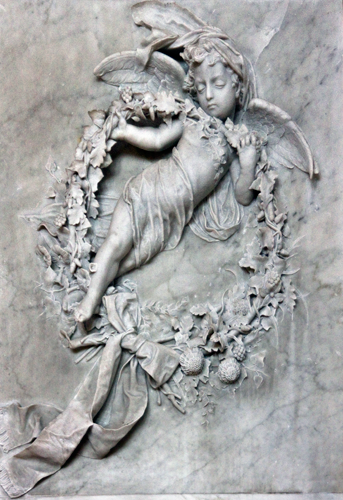
The
tomb of the heroes of the Risorgimento
Domenico Moro and Attilio & Emilio
Bandiera 1844 |
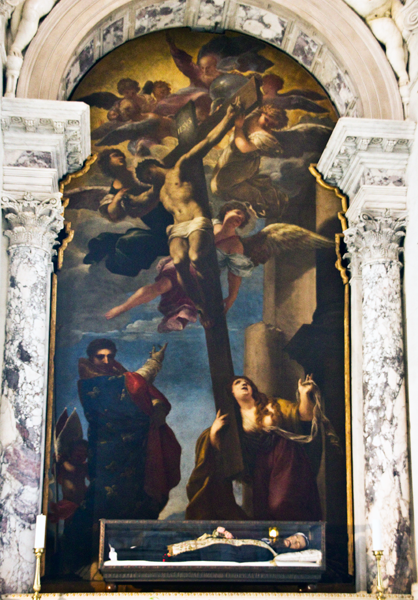 |
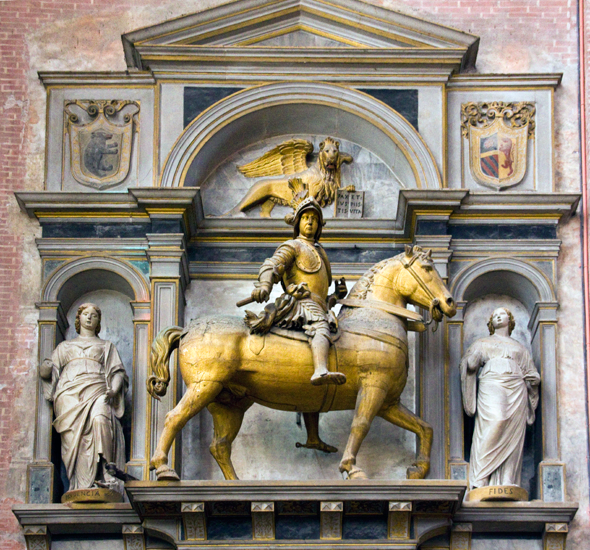 |
Above Centre: The chapel of the Name of God, now the Chapel of the Beatified Giacomo Salomoni. It was erected in the
mid 14th century in honour of Ludovico de Tolosa. The altar
piece is La Maddalena and St Louis of Toulouse at the foot of
the Crucifix (1650) in remembrance of the first dedication of
the chapel. It is considered to be the first work by Pietro
Liberi. Placed at the altar are the remains of
Giacomo Salomoni 1231-1314,
a Dominican son of the adjacent convent. It was believed his
miracle was the ability to invoke against tumours.
Above Right: Niccolo di
Pitigliano, Count of Orsini,
mounted upon his war horse from Colleoni and flanked by Faith
and Prudence. (1442-1510)
Born in Pitigliano to Aldobrandino II, Count of Pitigliano and
his wife Bartolomea. Coming from a famous family he made his
name as a mercenary, taking contracts from Florence, Siena,
Naples and the Pope amongst others. 1495 until he died he was
Governatore Generale delle Milizie Veneziane. In 1509 he opposed an
attack by the French King Louis XII, but due to in house
fighting between Pitigliano and Alviano failed to unite their
forces and this resulted in Alvasino's army being slaughtered in May.
Pitigliano's forces deserted and he was forced to retreat. The
French had won and proceeded to occupy vast amounts of Venetian
land. By November he had regrouped and easily defeated the army
that he faced, although he was later driven back to Padua after
the advance at Po River. He was married twice: firstly in 1467
to Elena dei Conti Montalcino and secondly to Guglielmina, a
woman of common birth.
|
|
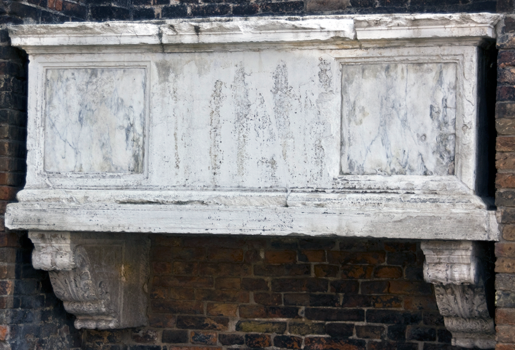 |
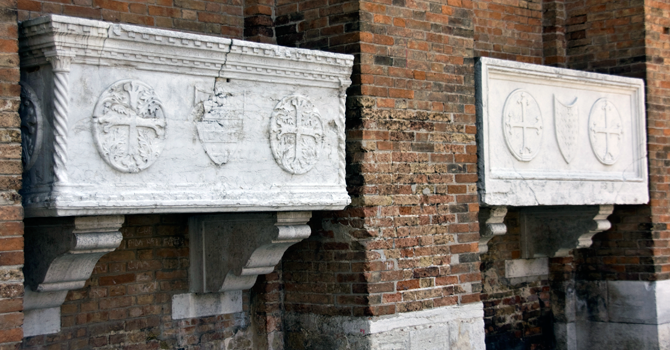 |
| Various unattributed sarcophagi |
|
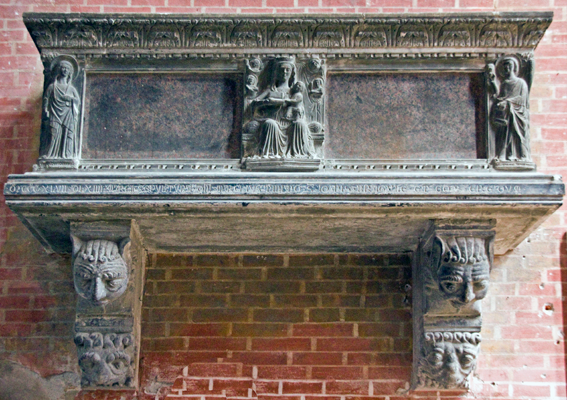
Above: Believed to be the tomb of St
Loredan, and has been credited to Tajapiera
from the second half of the 14th century.
Near right:The tomb of Senator and scholar
Alvise Michiel who died in 1589
and was created by the school of Alessandro Vittoria
Far right: Senator Giambattista Bonzio,
erected in 1525 and attributed to Gian Maria Padovano.
|
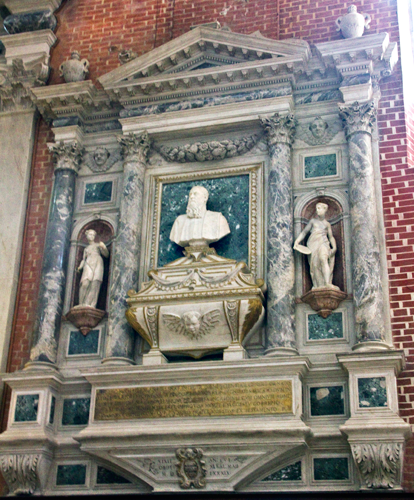 |
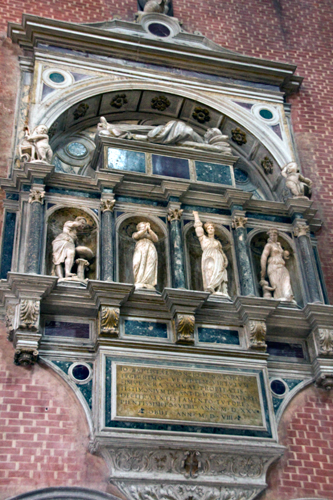 |
|
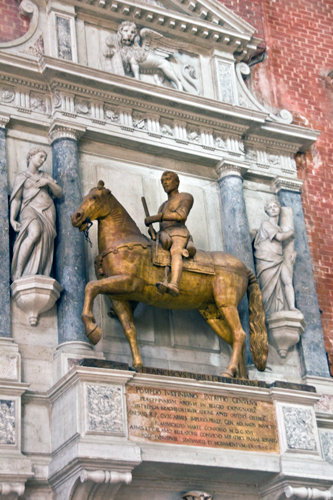 |
Pompeo
Giustiniani
By Francesco Terilli da
Faltre |
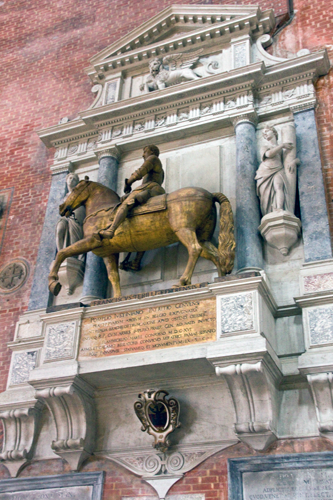 |
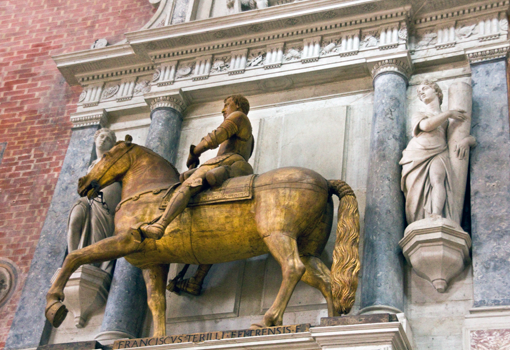 |
| Pompeo was born in 1569 in Ajaccio. He was
14 when he began his military career. In 1602 during the Siege
of Ostend he was promoted to Mastro di Campo. He later wrote a
text "Delle guerre di Fiandra" based on his experiences and had
it published in 1609. In 1613 he entered the Venetian army, but
argued with the other officers at Uskok. In 1616 he besieged
Gradisca but had to withdraw because the Habsburg forces were
too strong. In 10 October 1616 he was killed by the enemy army at
Lucinico. |
|
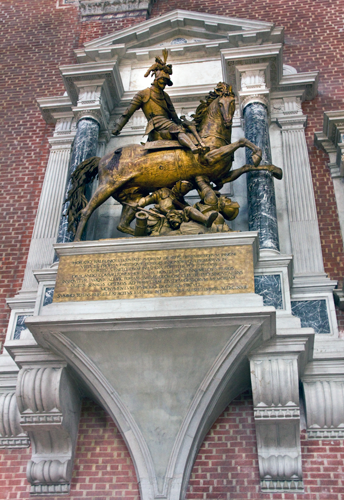 |
Perugian Orazio Baglioni |
Melchiorre
Lanza |
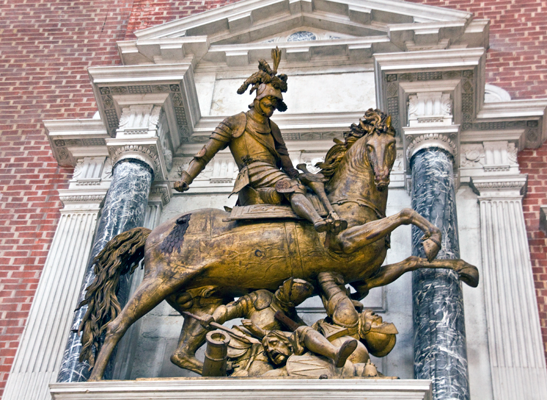 |
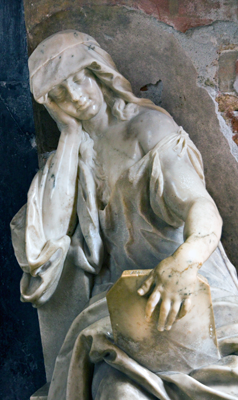 |
|
The equestrian monument to Perugian Orazio Baglioni
who died in
1617 and is remembered for his vehemence and determination in
defending against the enemy. |
A monument honouring
the painter Melchiorre Lanza who died in 1674.
The monument is better known as the "Melancholy", and was
created by Melchiorre Barthel, a Dresden sculptor who was
living in Venice at the time. |
|
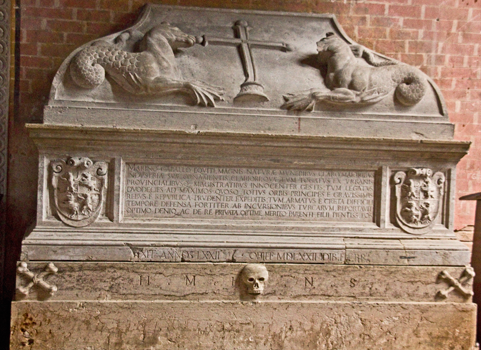 |
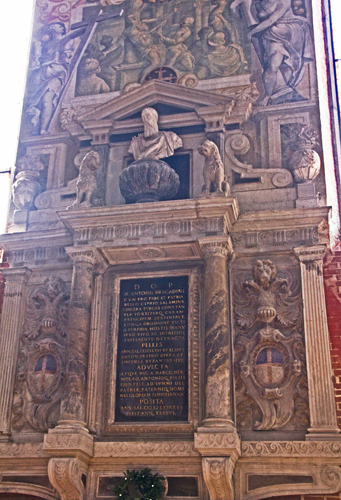 |
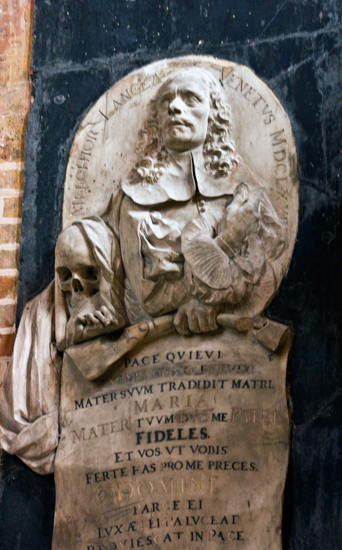 |
Above: Marino
Cavalli (1572)
Above right: Marcantonio Bragadin (1571)
See note below.
Above far right: Marco Giustiniani della Bragora.
An Ambassador to Serenissima
|
|
The Monument to Marcantonio Bragadin, attributed
to Vincenzo Scamozzi, with a fresco above depicting the scene of
Martyrdom of Mercenary Leader, which is attributed to Cosimo Da
Castelfranco. Marcantonio Bragadin was born 21 April 1523. He was a
lawyer in 1543, but decided to pursue a career in the navy. In 1560 he
was made a city magistrate, and in 1566 a galley governor. In 1569
he was elected as Captain of the Kingdom of Cyprus and moved to
Famagusta which at that time was a rich and wealthy port. He assumed
civil governorship over the whole island. He worked hard to fortify
Famagusta. The Turks landed in Cyprus on July 3, 1570.They besieged
Famagusta in September. Brigadin had joined the Fanti da Mar Corps of the
Republic of Venice. In 1569 he was appointed Captain General of
Famagusta in Cyprus. On 31st July 1571 after a long and brutal siege he
agreed to negotiate terms of surrender. Terms were accepted and the
Ottoman leaders allowed all Christians to leave the city in peace under
their own flag. This happened for four days with no problems, but on the
fifth day during the presentation of the city to the Ottomans, their
General Mustafa started to behave strangely accusing Bragdin of
murdering Turkish prisoners. Mustafa then pulled out his knife and cut
off Bragadin's right ear. He ordered his guards to cut off the other ear
and his nose. The order was then given that any remaining Christians
were slaughtered. Bragadin was thrown in prison for two weeks with
festering wounds before he was dragged round the city walls with sacks
of stones and earth on his back. When they had finished humiliating him,
they tied him naked to a post in the centre of the square and he was flayed
alive. They abused his quartered body further before sending what
remained as a gift to the Sultan Selim II of Constantinople, where it
was kept in the treasury. It was captured by a Venetian officer, Girolamo
Polidori in 1580. The skin was returned to the church and preserved. in
Venice where he was considered a Martyr. |
|
| Leonardo
Prato (1511) |
Edward,
Duke of Windsor (1574) |
Doge Tommaso
Mocenigo (1423) |
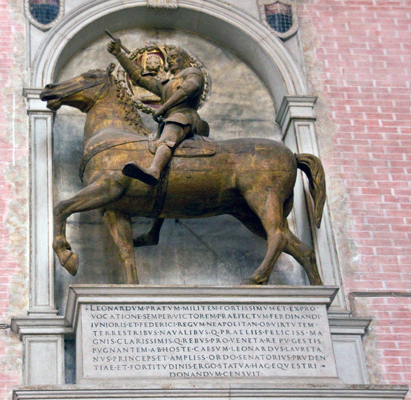
Attributed to Lorenzo Bregano
|
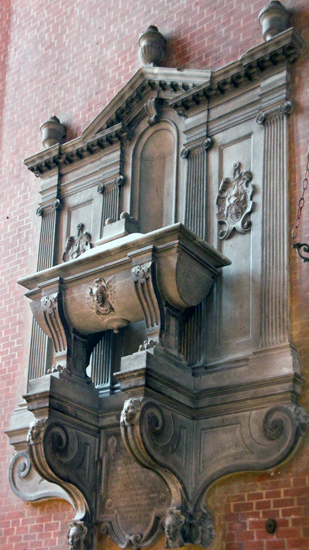 |
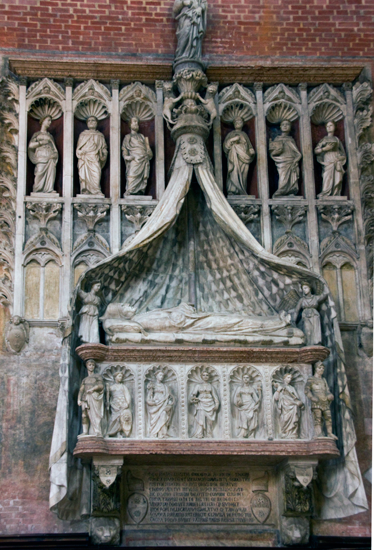 |
|
| |
Above
centre: The monument to Edward, Duke of Windsor
(1574) attributed to
Alessandro
Vittoria. Sir Edward Windsor, 2rd Baron Windsor was born in
1532. He was married to Katherine de Vere, the older half sister of
Edward de Vere, 17th Earl of Oxford. On 2 October 1553, the day
after the coronation of Queen Mary, he was appointed a Knight of the
Carpet. In 1557 he fought in the battle of St Quentin during the
Italian wars, under the English forces of Frances Russell, 2nd Earl
of Bedford. In 1566 he was visited at the family home by Queen
Elizabeth, but because he was a firm Roman Catholic he spent many
years living in Europe. He died in Venice in 24 January 1574. |
|
Below and above right: The monument to Doge Tommaso Mocenigo
(1423) by
Pietro Di Niccolo
Lamberti and
Giovanni Di Martino da Fiesole.
Born in 1343, he was in command of the crusading fleet in the
expedition to Nicopolis in 1396. 1378-81 he won the battle
against the Genoese during the war of Chioggia. He was Venetian
ambassador at Cremona, during which posting he was elected doge
in 141. He was thus forced to escape fearing he would be held
prisoner by Gabrino Fondolo, tyrant of Cremona. His fleet would
later defeat the Turks at Gallipoli. He reconstructed the ducal
palace and started the new library. He died after a long illness
in 1423. |
|
|
|
|
Doge Sebastiano
Venier (1578) |
Doge Pietro
Mocenigo (1476) |
Doge
Michele Morosini (1382) |
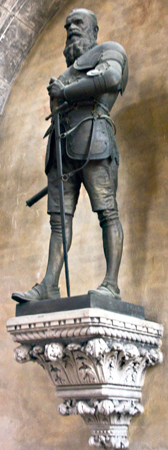
|
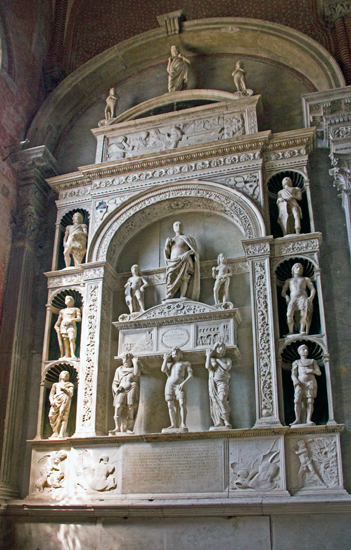
|
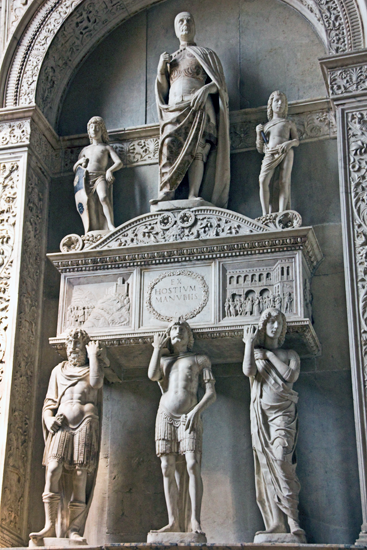 |
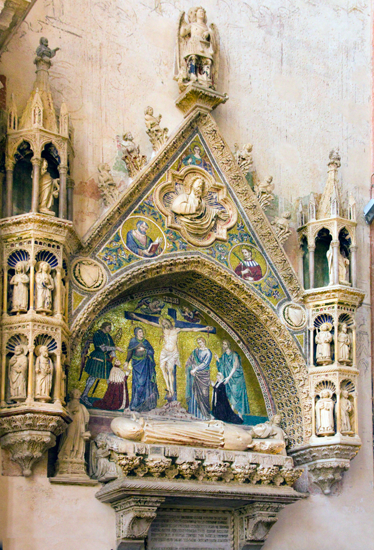
|
Above monument and detail:
Doge Pietro Mocenigo;Monuments attributed
to Pietro Lombardo. He was born in1406. He became a
great admiral who revived the fortunes of the Venetian navy.
In1472 He captured and destroyed Smyrna; in1473 He placed
Catherine Cornaro, Queen of Cyprus under the protection of the
Venetian state which meant they obtained the island in 1475.
In 1474 He was elected Doge. In 1475 he defeated the Turks at
the siege of Scutari, where he contracted an illness and died in
1476.
Left:Monument to the Mercenary
Sebastiano Venier by Antonio Dal Zotto.
Sebastiano Venier was born 1496 the son of Moise Venier and
Elena Dona. He worked as a lawyer from an early age and later
became an administrator for the Venice Government. 1570 he was
procurator and later Capitano generale de mar of the Venetian
fleet. He was commander at the Battle of Lepanto in 1571 in
which the Christians defeated the Turks. 1577 at the age of 81
he was elected doge. He was married to Cecilia Contarini with
whom he had a daughter, Elena, and two sons. He died in March
1578 allegedly of a broken heart after a fire heavily damaged
the Doges Palace |
Above: The monument of Doge Michele Morosini. The
mosaic depicts the Doge and his wife Christina Bondumier kneeling
and praying before Christ on the Cross.Michele Morosini was born
in 1308 into one of the wealthiest families in Venice. He was
elected Doge in June 1382 but died of plague in October the same
year. |
|
| Doge
Marco Corner (1368) |
Lucius Comanus
Patritus |
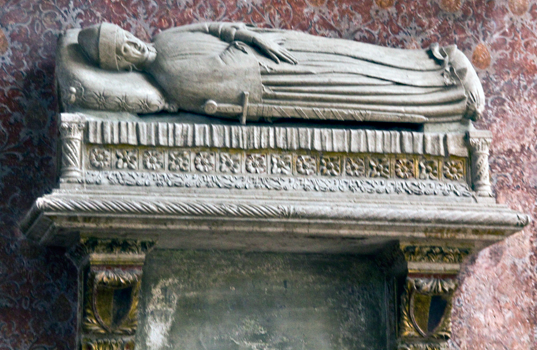 |
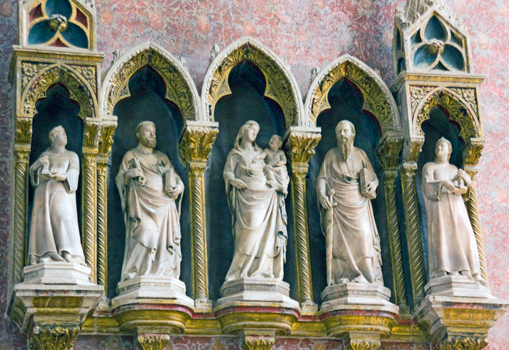
|
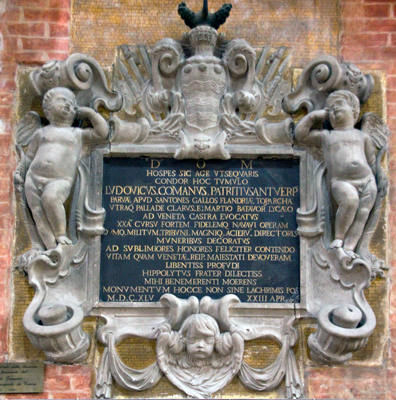 |
| The monument to Doge Marco
Corner with saints and the Virgin in niches above him, by
Nino Pisano. Doge Marco Corner was born in 1285. He became
Doge in July 1365 and died in 1368 |
No information available |
|
| Doge
Leonardo Loredan |
Doge Pasquale Malipiero (1462) |
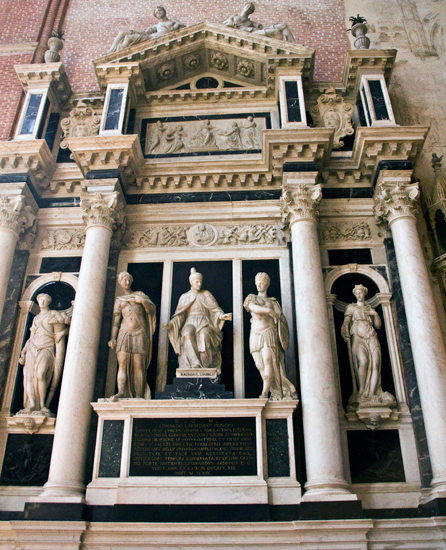 |
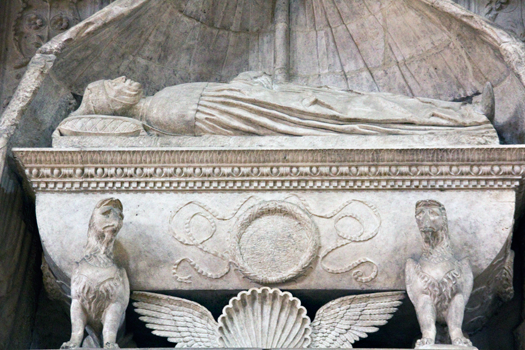 |
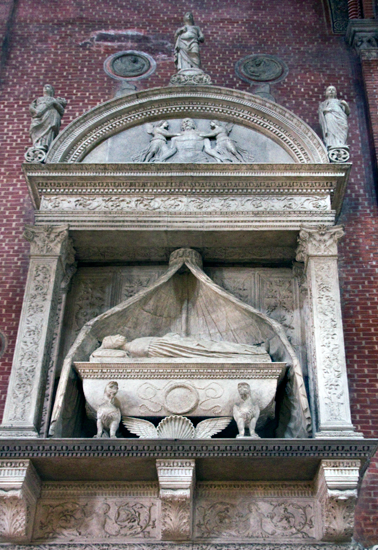 |
Left:
The monument to Doge Leonardo Loredan by
Girolamo Grapiglia in 1572 with statues by Danese
Cattaneo picturing Venice, The Cambrian League and the virtues
of peace and Bounty. Leonardo Loredan was Doge 1501-21
Above and right: The monument to Doge Pasquale
Malipiero by Pietro Lombardo c.1470 He was born in 1392
and was a statesman before becoming Doge in October 1457. He was
responsible for passing a law that limited the power of the
Council of Ten. He died 7 May 1462. |
|
| Doge Nicolo
Marcello (1474) |
Doge Jacopo Tiepolo (1229-1249)
and his son Lorenzo (1268-75) |
 |
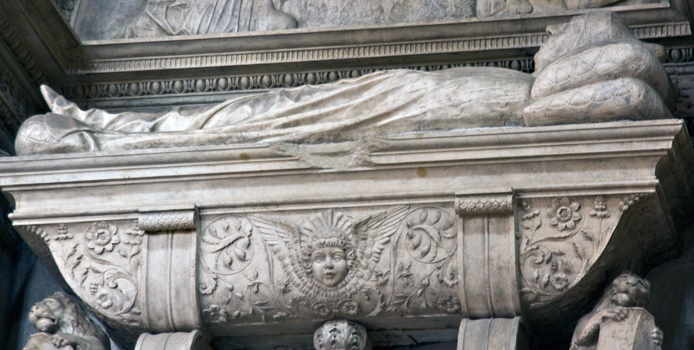 |
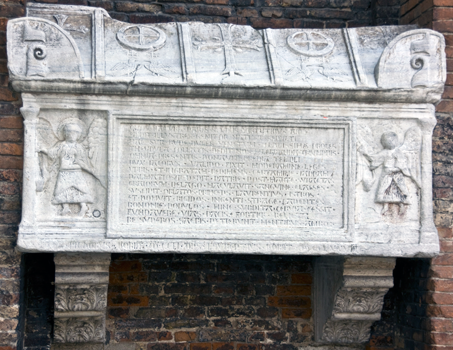 |
Left
and above left: Monument to
Doge Nicolo Marcello attributed to Pietro Lombardo,
displayed with the four virtues and the eternal Father. Nicolo
was born in 1399, he was a trader with the Orient before
becoming a state figure including Provost tot he Council of Ten.
He married twice, firstly to Bianca Barbarigo and then,
secondly, to contarina Contarni. 1473 he was elected Doge during
which time he devoted his time to reorganizing the state
finances of Venice. He introduced a new silver coin called
Marcello. He died in December 1474.
Above right: Doge Jacepo Tiepolo (1229-1249) and his
son Lorenzo (1268-75). The decoration on the tomb alludes to a
dream had by the Doge which led to the land being donated for
the building of the church. Before he was elected Doge he served
as first Duke of Crete and Podesta in Constantinople (1218-20 /
1224-27). He went for election as Doge in 1229 against his rival
Marino Dandolo. The election was tight, the original count being
20 votes each. It would later lead to a rift between the two
families. In 1242 he proclaimed statuto, the Codification of
Venetian Civil Laws. In 1240s The Great Mendicant, where the
orders of the Dominican and Franciscan orders were granted land
on which to build the two largest churches in Venice: the Sant
Giovanni e Paolo-Santi and Basilica di Santa Maria Gloriosa dei Frari.
In 1249 he abdicated as Doge and retired to the family home
where he died a couple of months later on the 19 July 1249.
Lorenzo was the son of Jacopo and his second wife Marguerite the
daughter of the King of Romania. In 1257 he commanded during the
War of Saint Sabas with the Genoese whom he defeated at Acre.
Served as Podesta of Fano. In 1268 elected Doge with 25 votes
from 41. He was generally loved by the people but received much
hostility from the nobles because of the way he treated his
son. In 1273 Marco Polo set off for his exploration of China
under the Dogal blessing. In 15 Aug 1275 he died. |
|
| Michele Steno
(1413) and Alvise Trevisan (1528) |
Doge
Giovani Dolfin (1361) |
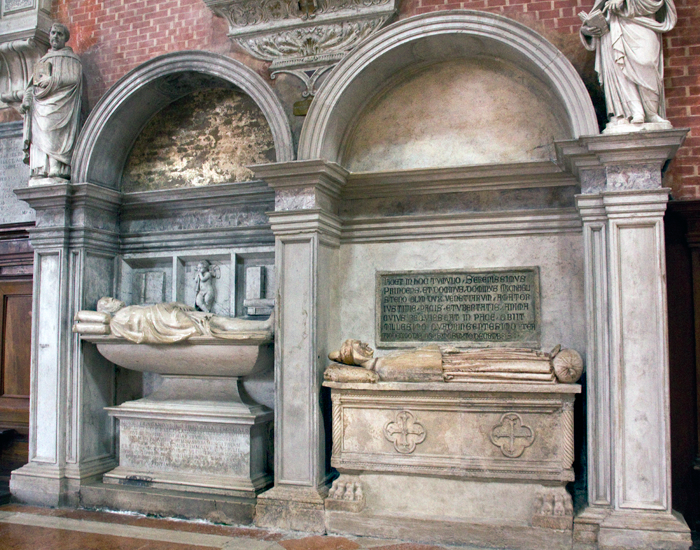 |
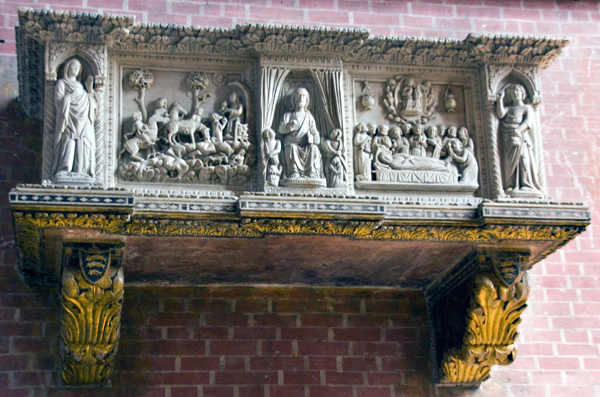 |
Left:
The double monument to Michele Steno and
Alvise Trevisan. Michele Steno was born in 1331. As a young man
he was involved in an act of vandalism against the then Doge by
profaning his wife, and was nearly executed for the crime. He
later served as Proveditor of Venice, and was a capable diplomat.
In 1400 he was elected Doge. He died in December 1413. Alvise
Trevisan was a scholar who died in 1528. There is
another photograph below.
Above: Monument to Doge Dolfin by Andrea da San Felice.
The front panels depict The Adoration of the Magi, the doges and
their wives adoring Christ on the throne and the passing away of
the Virgin Mary. The end figures represent the annunciation.
Born into a wealthy family he was elected Doge in August 1356.
During his rule there was much unrest in the Venetian colonies.
He died in July 1361 |
|
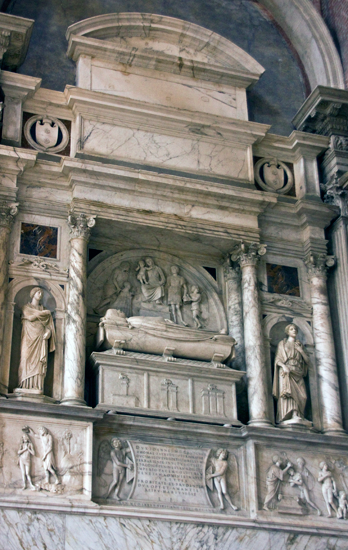 |
Giovanni
Mocenigo (1485) |
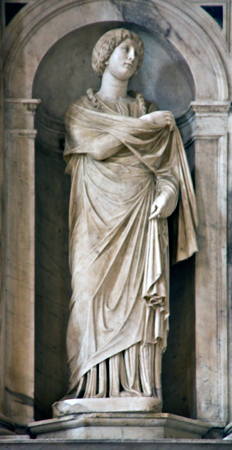 |
 |
| Monument to Doge Giovanni Mocenigo, attributed to
Tulio
Lombardo in 1552. The carvings of the base relief is
attributed to Antonio Lombardo, and illustrate the
Baptism of Christ and St Mark Baptising Aniano and his
family. Giovanni Ser di Mocenigo Jr was born in 1409. He
fought at sea against the Ottoman Sultan Mehmed II and also
against Ercole I d'Este, Duke of Ferrera, from whom he
captured Rovigo and Polesine. It is speculated that he was
killed by poisoning. in 1485. He was Doge from 1478 |
|
|
Doge Andrea Vendramin (1478) |
|
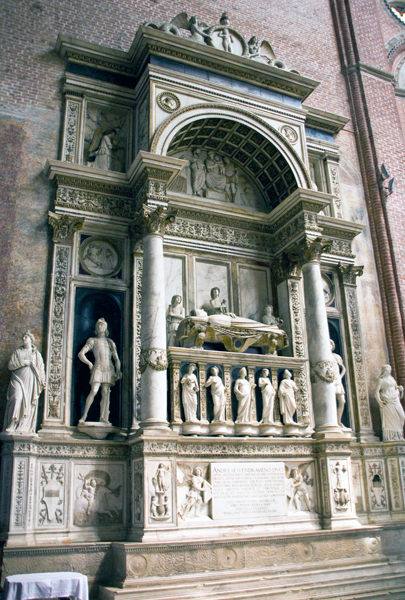 |
|
| Monument to Andrea Vendramin by Tullio Lombardo 1493,
surrounded by the seven virtues. Andrea Vendramin was born in
1393 to Maria Michiel. He served as Venetian Procurator in Rome,
and also had a joint shipping venture with his brother importing
food from Alexandria. He was elected doge in 1476 which caused
so much ill feeling that Antonio Feleto was imprisoned and then
banished for calling him a cheesemonger doge. He married Regina
Gradenigo had six daughters. He died of plague in May 1478
|
|
| Doge Alvise
Mocenigo and
his wife Loredana Marcello |
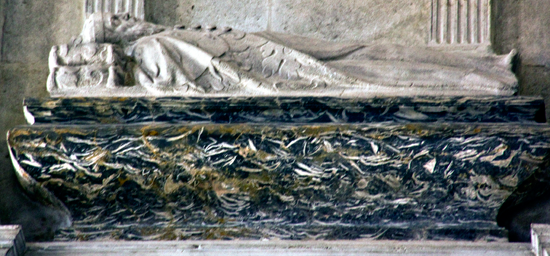 |
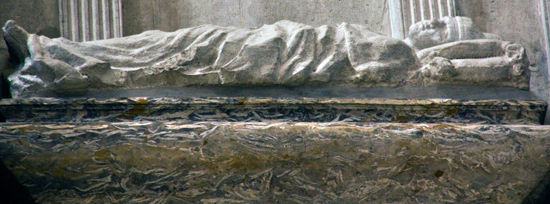 |
| The monument to Doge Alvise
Mocenigo and his wife Loredana Marcello. The work was begun in
1577 by Girolamo Grapiglia
and was finished in 1646 by
Francesco Contin. The monument is so huge that it
encompasses the entire facade of the entrance and includes the
monument to Bartolomeo Bragadin from 1507. Alvise I Mocenigo was
born 26 October 1507. He was a diplomat for Venice at the Court
of Emperor Charles V in 1545 and to Pope Paul IV in 1557 before
returning to the imperial court in 1567. In 1570 he was elected
as Doge. During his rule Venice lost the fortresses of Nicosia
and Famagusta. He died 4 June 1577. |
|
|
Doge Antonio
Vernier |
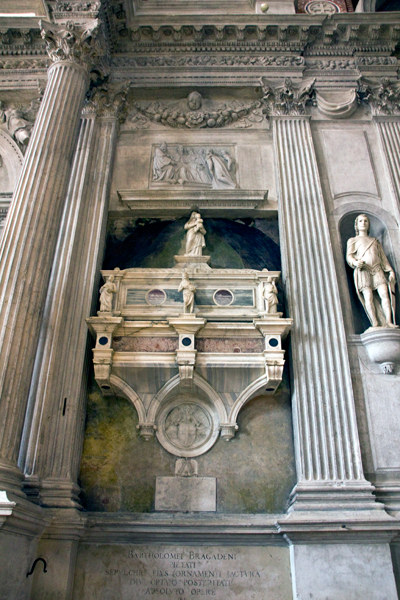 |
Bartolomeo
Bragadin |
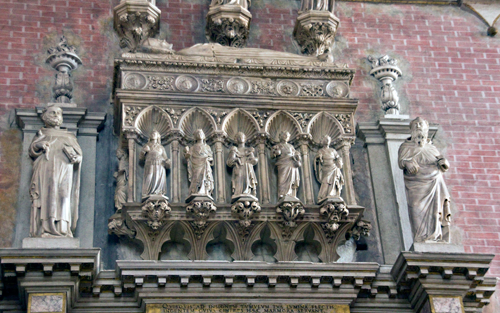 |
 |
Above:
The monument to Doge Antonio Vernier
by Dalle Masegne, upon which five niches hold the
virtues. To the side is the Saint Dominic and Anthony the
Abbot. Above is the virgin Mary flanked by St Peter and
Paul. Antonio Venier was born in 1330. He married Agnes da
Mosto. 1380 he was in the army at the rank of Superintendent
in the Fortress of Tenedos. 1381 became Captain of Crete.
1382 he was elected Doge. His rule was not an easy one
annotated by years of floods and plagues, plus brutal wars
abroad. He also had problems with his son Alvise which led
to mockery of the family through his adulterous ways. He was
imprisoned and fell ill there, but his father did not
release him. He died in November 1400
Left near and far:Monument to the poet Bartolomeo Bragasin, who died in 1507, and
whose monument was incorporated into the Alvise Mocenigo
monument |
|
| Dogaressa
Agnese Vernier |
Alvise Diedo |
Captain Girolamo Canal |
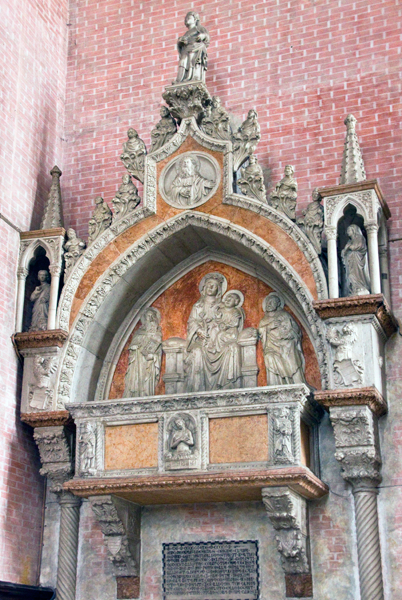 |
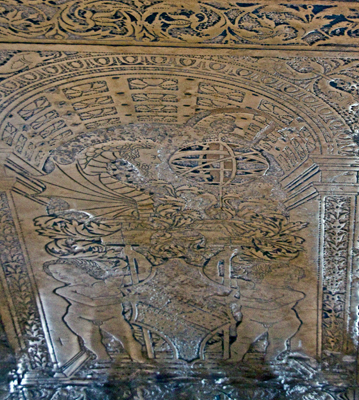
|
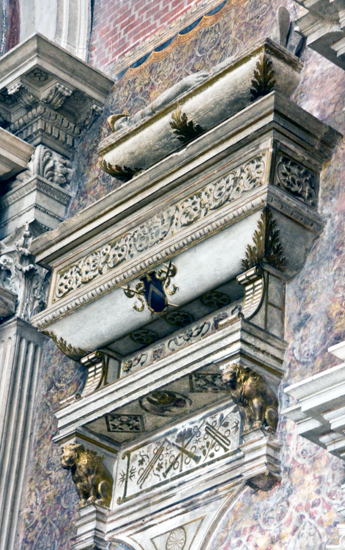 |
Left:
The monument to the Dogaressa Agnese Vernier
who died in 1410. It also remembers her daughter Orsola who
died in 1471 and her daughter in law Petronilla de Toco. The
relief depicts the Pity, John the Baptist and Peter the
Martyr. The Madonna is flanked by Saint Anthony the Abbot
and Saint Dominic
Above: The funeral slab to
Alvise Diedo who was
famous for saving the Venetian Fleet at Constantinople in
1453. He
died in 1466 and the slab is attributed to
Pietro
Lombardo
Right: The monument to Captain Girolamo Canal who died
in 1535 |
|
| Gabrriele de Chastellier |
|
Bartolomeo Colleoni (1475) |
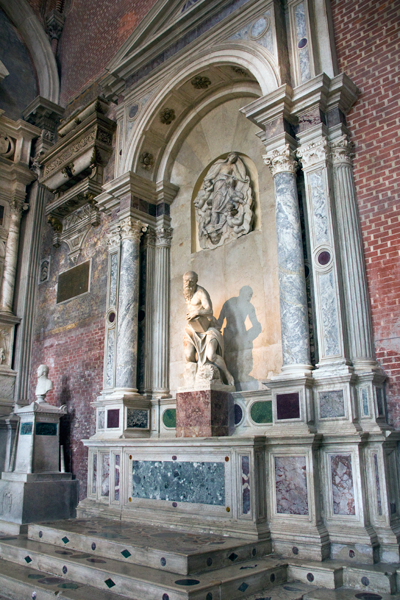 |
|
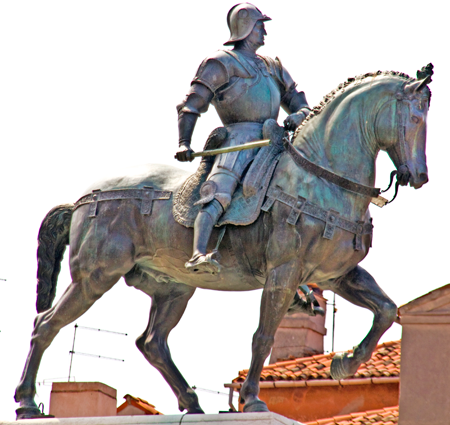 |
| |
Above: Bartolomeo Colleoni (1475)
Right: The altar of St Jerome with the tomb of
Gabrriele de Chastellier |
|
|
|
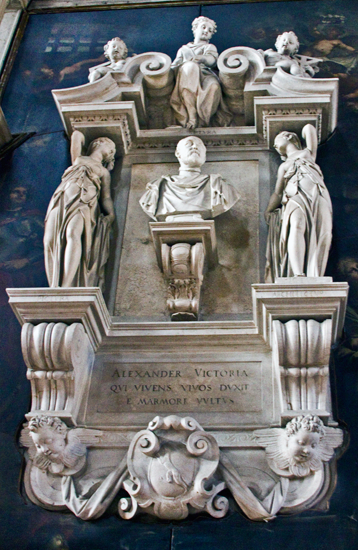 |
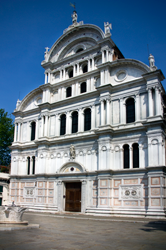 |
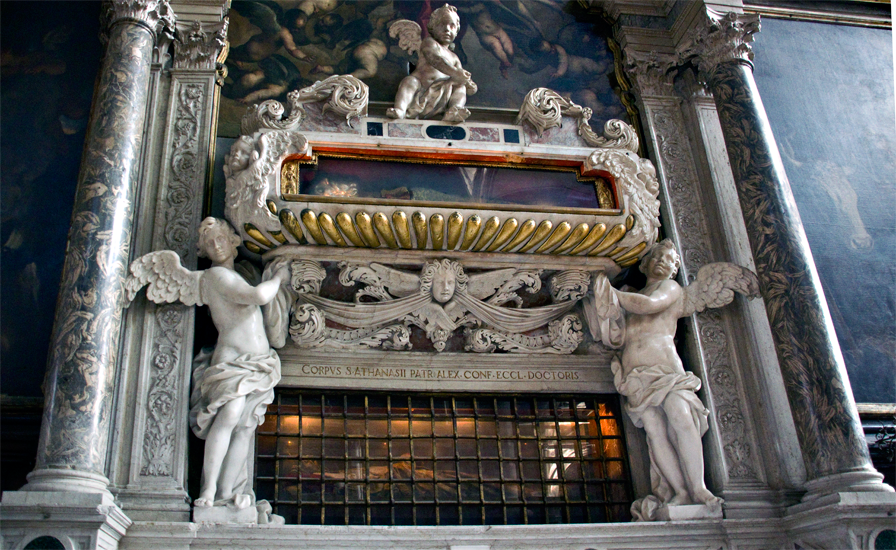 |
Above:
Exterior of the Basilica
Left: Alessandro Vittoria
Right: Tomb of St Anthanus
Below: Marco Santusfranc
|
|
| |
| Notes |
The Doge (plural:
doges or dogi) was the head of state in the republics of
Venice and Genoa. The office of doge (dogeship) had a different
form in Genoa to Venice so will not be dealt with here. The doge
was elected for life by a committee of forty, who were chosen by
four men selected from the Grand Council of Venice, which had
2000 members, and was itself nominated annually by twelve
persons. The doge's power was not absolute but was under strict
surveillance. A dogaressa was the wife of a doge.
Many of the monuments are wall mounted, sometimes quite high
so it is not possible to see the effigy let alone photograph it.
This is because it was not possible to construct a crypt in
Venice because of the water levels. Sometimes the effigies are
tilted towards the observer so the obsever may see them,
although this can look oddly unstable.
|
|
| |
| With grateful thanks to Amanda Miller of Amanda's
Arcadia for supplying all the photographs and information on this page |
| |
| <Top of Page>
<Home - Index - Page> |
| |
